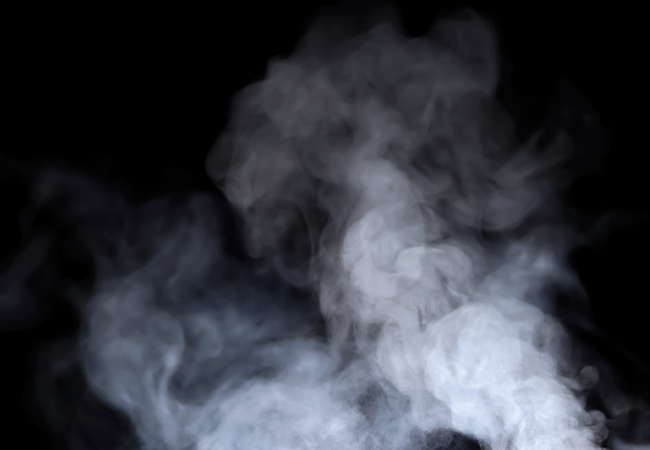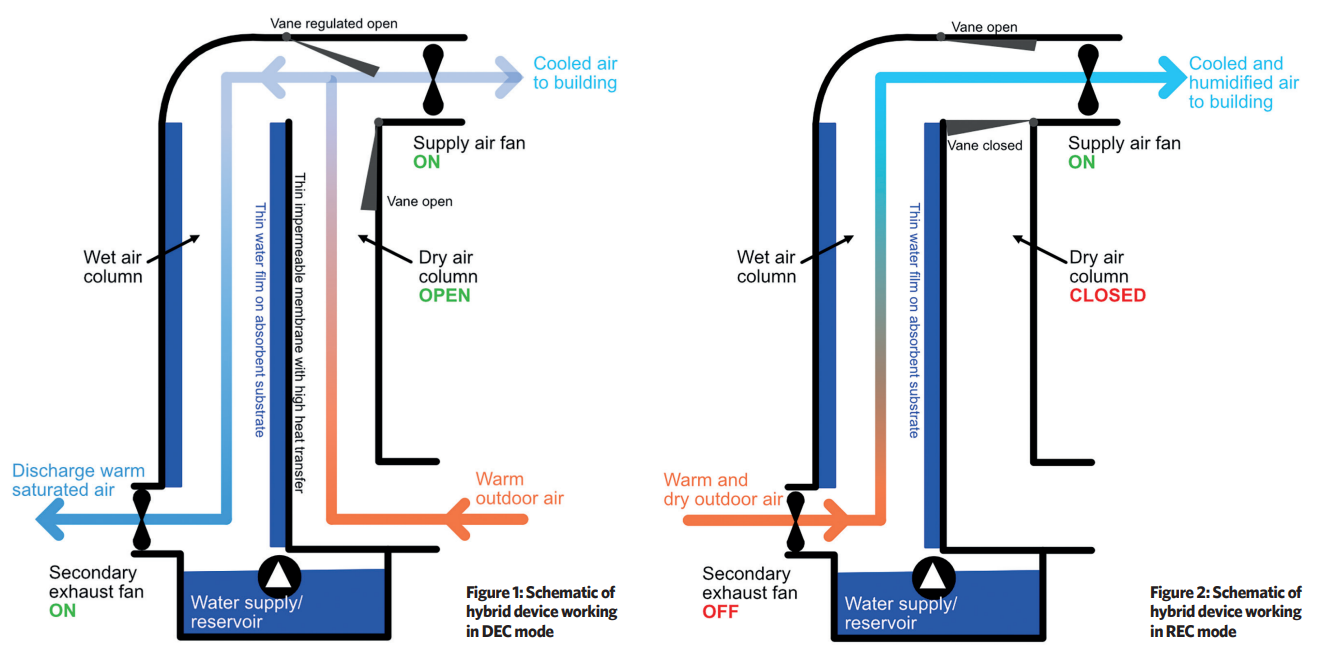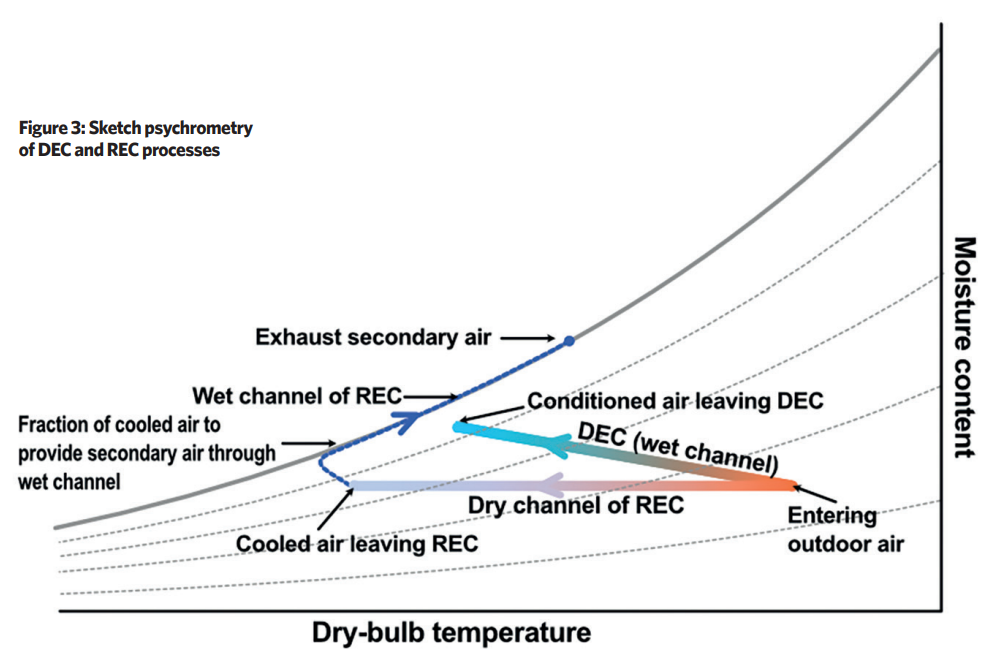
Although particularly effective for drier climes, the simple direct evaporative cooler (DEC) is successfully employed in many climates to reduce incoming outdoor air dry-bulb temperature towards its wet-bulb temperature, as discussed in CPD 135, in the November 2018 CIBSE Journal CPD special.
This has the benefit of not requiring mechanical cooling devices. However, as the dry-bulb temperature is reduced, the associated increase in absolute humidity of the cooled air may not be desirable in some situations.
Various forms of indirect evaporative coolers (IEC) overcome this, where cooling is provided from the evaporation of water into a secondary airflow, from a continuously wetted surface running along the channel length of a heat exchanger.
This reduces the temperature of the water film and the dry-bulb temperature of the secondary air that is separated by a thin, impervious heat-transferring layer/membrane from the counter flowing primary system air, which is then cooled by passing over the low-temperature heat-transfer membrane surface.
Both primary and secondary airflows often originate from the same outdoor air, and the secondary air will be typically rejected to outdoors after it has achieved its work of cooling the membrane by absorbing the evaporated water vapour.
The cooling energy in the DEC mode is higher than REC, so the direct mode may be more suitable for places with high sensible heat loads where the increase in moisture content is not an issue
The primary airflow is cooled towards the wet-bulb temperature of the entering air, but gains no humidity, so it is a sensible cooling process, often referred to as ‘dry cooling’, but is less effective than a DEC. (James Falconer discusses such systems in ‘Making the case for evaporative cooling’ in June 2017 CIBSE Journal.)
The so-called ‘regenerative evaporative cooler’ (REC), based on the principles as variously published by Maisotsenko1 (and sometimes referred to as an ‘M-cycle cooler’) is a development of the IEC. The secondary airstream in an REC is supplied by splitting off a proportion of the conditioned air from the outlet of the primary airstream and enables the cooler to reduce the outlet primary air towards its dew-point temperature (ie, cooler than its wet-bulb temperature). This is discussed in ‘Clothes to zero’ in the March 2018 CIBSE Journal, with examples showing how it can be applied to satisfy cooling loads in a wide range of climates.
This technology continues to be developed, both by academics and commercially, and a recent research exercise, reported in BSER&T, provides a useful reminder of the growing interest in applications of regenerative evaporative cooling for air conditioning purposes.

This work considered a prototype of a dual-mode evaporative cooler (a two-in-one device) that can operate in either direct or regenerative mode, depending on the seasonal climatic condition. The paper reports on exergy and economic analyses that were performed to check the suitability of both modes of operation, direct and regenerative, for cities that are indicative of five international climate zones. The dual-mode cooler works in either REC or DEC mode, depending on the outside condition. There is a reversible-flow wet air column used in both DEC and REC mode, and a dry air column only employed for REC mode – the flow arrangement being dependent on the positions of the two vanes and actuation of secondary air exhaust fan, as shown in Figure 1 and Figure 2.
In DEC mode, the air is cooled and humidified by passing only through the wet channel (with the secondary exhaust fan off). In REC mode, the outdoor air is cooled sensibly. A proportion of this cooled dry air is sent to provide space cooling and the remaining fraction of the air is drawn by the exhaust fan through the wet channel, where it is humidified and further cooled and discharged to atmosphere. The dual-mode evaporative cooler can be switched from DEC mode to REC mode and vice versa as the outdoor air conditions change.
Sketch psychrometric processes for both modes of operation are shown in Figure 3.

The month-by-month analysis indicated that the cooling energy in the DEC mode is higher than REC, so the direct mode may be more suitable for places with high sensible heat loads where the increase in moisture content is not an issue – such direct evaporation methods are often used in applications such as data centres.
The exergy efficiency for REC mode is higher than DEC mode and independent of the climatic zone. However, the annual cost of operating the REC mode is always higher, being significantly affected by electricity charges. The paper shows that, with automated switching operation (based on incoming air wet-bulb temperatures) to select between the DEC or REC mode, significant operational savings can be made, particularly in a composite climate zone, as across large parts of mid-northern India.
- The full paper – Energy, exergy and economic assessments of the dual-mode evaporative cooler for various international climate zones – by Sarvesh Kashyap et al of the Indian Institute of Technology (BHU), Varanasi, India, may be seen in BSER&T at
bit.ly/CJMar22BSERT - Tim Dwyer is CIBSE Journal technical editor and BSER&T managing editor
References:
- Mahmood M et al, Overview of the Maisotsenko cycle – A way towards dew point evaporative cooling, Renewable and Sustainable Energy Reviews, Volume 66, December 2016, pages 537-555.
